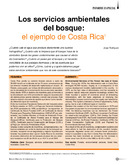Los servicios ambientales del bosque: el ejemplo de Costa Rica

Voir/
ISSN
e-ISSN: 1021-0164Date
01-2002Auteur
Rodríguez, Jorge
Type
Artículo
Metadata
Afficher la notice complèteAlternative title
Environmental services of the forest: the case of Costa Rica
Description
7 páginas, 2 figuras, 3 tabulaciones,
Résumé
Costa Rica perdía su cubierta forestal natural a razón de
50.000 ha/año en la década de los 70 como consecuencia de
los diversos modelos de desarrollo implantados en el país. El
Estado, preocupado por la tasa de deforestación alcanzada y
por la necesidad de la conservación de sus recursos naturales,
inicia desde 1979 un sistema de incentivos para el fomento a
la reforestación con el fin primordial de asegurar la producción
de materia prima para la industria y revertir ese proceso. Este
sistema requirió una serie de ajustes que dieron como resultado diferentes tipos de incentivos.
Entre los Incentivos Fiscales de Deducción del Impuesto sobre
la Renta creados en 1979, y el Pago por Servicios Ambientales (PSA) aprobados en 1996, se identifican los siguientes: el
Certificado de Abono Forestal (CAF), el Certificado de Abono
Forestal para Pequeños Reforestadores (CAFa/CAF por adelantado), los Créditos Blandos, el Fondo de Desarrollo Forestal, el Certificado de Abono Forestal para el Manejo del
Bosque(CAFma) Certificado para la Protección del Bosque
(CPB), Certificado para la Conservación del Bosque (CCB) y
el Pago por Servicios Ambientales (PSA).
Gracias a este conjunto de incentivos, compensaciones y esfuerzos estatales por evitar la destrucción de los bosques nacionales, recuperar zonas degradadas y mejorar la producción
forestal, hoy podemos decir que en Costa Rica se ha revertido
el proceso destructivo de los bosques al pasar de una cobertura forestal en los 80 de 30,4% a un 45,4 % en el 2001. Environmental Services of the Forest: the case of Costa Rica. During the 1970s, the deforestation rate in Costa Rica averaged 50,000 ha/year, largely as a consequence of the various development models implemented in the country. In 1979, as the high rates of deforestation and the necessity to conserve natural resources became increasingly evident, the State founded a system of incentives aimed at stimulating reforestation, with the basic objectives of reversing the deforestation process and ensuring the supply raw material for industry. This system underwent a series of adjustments, finally giving rise to a set of different types of incentive. Between the creation of the first fiscal incentives in 1979 and the system of payment for environmental services approved in 1996, the followng incentives can be mentioned: the Forest Investment Certificate (CAF), the Forest Investment Certificate for small-scale tree-planters (CAFa), Soft Credits, the Forest Development Fund (FDF), the Forest Investment Certificate for Natural (CAFma), the Forest Protection Certificate (CPB), the Forest Conservation Certificate (CCB) and Payment for Environmental Services (PSA). As a result of this set of incentives, compensation systems and state efforts to halt the destruction of the country's forests, recuperate degraded zones and increase forest production, today it is possible to say that in Costa Rica the deforestation process has been reversed, as evinced by the increase in forest cover from 30.4 per cent in the 1980 to 45.4 per cent in 2001.
Keywords
Éditeur
Centro Agronómico Tropical de Investigación y Enseñanza (CATIE), Turrialba (Costa Rica)

